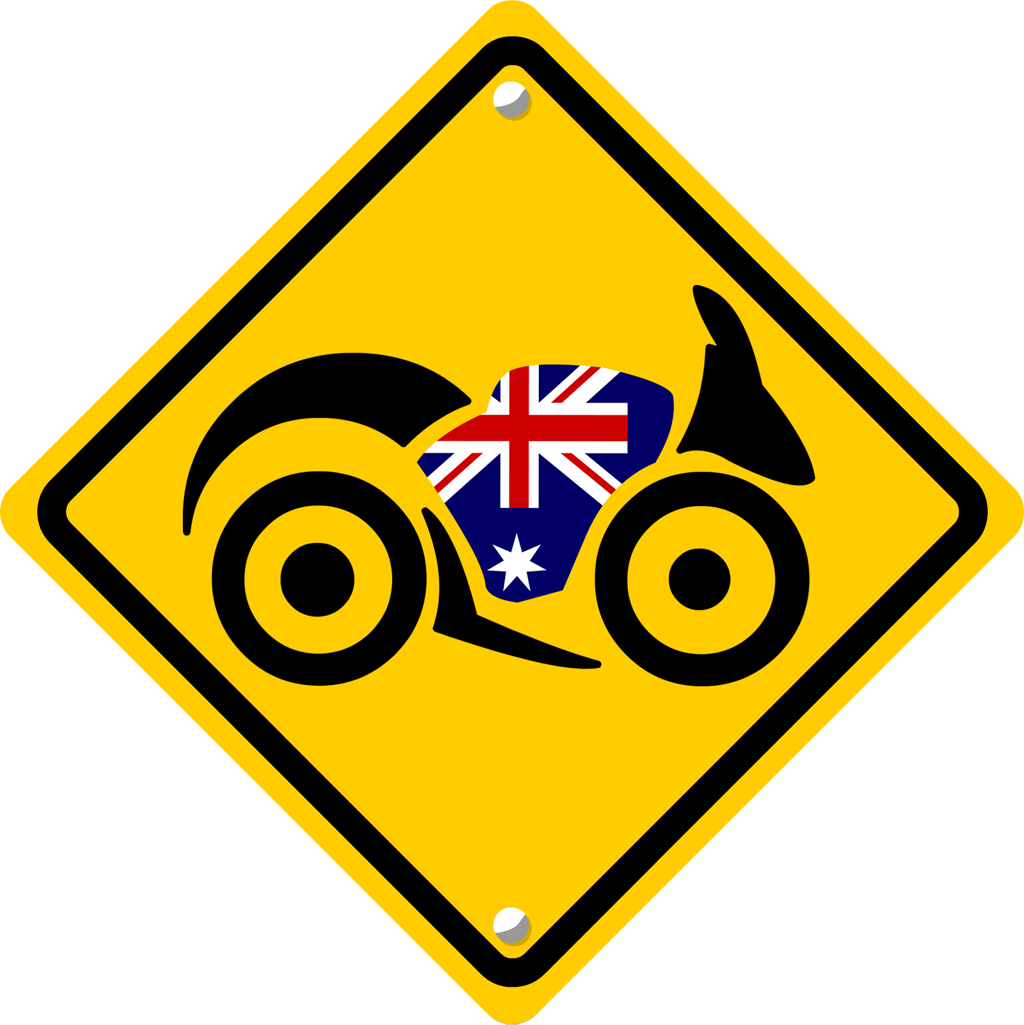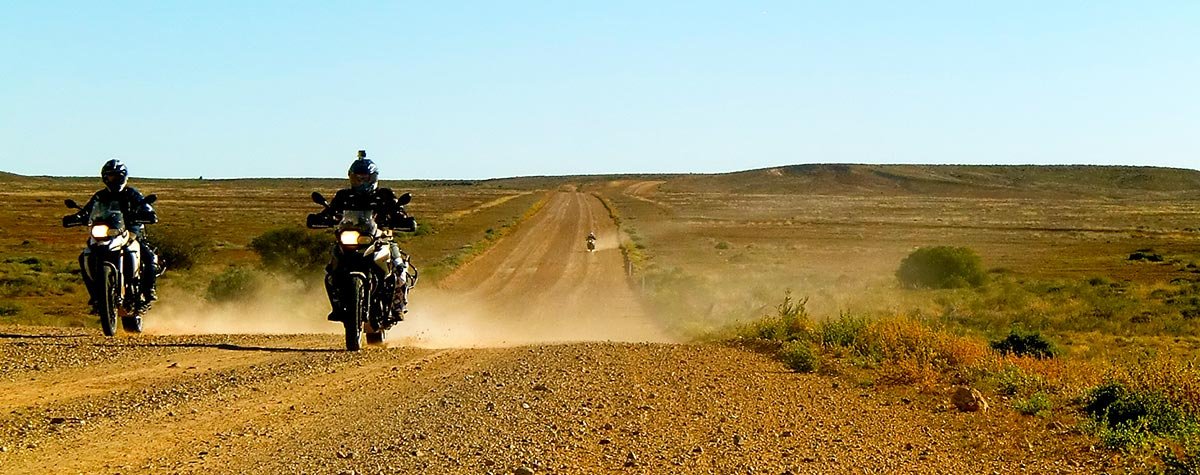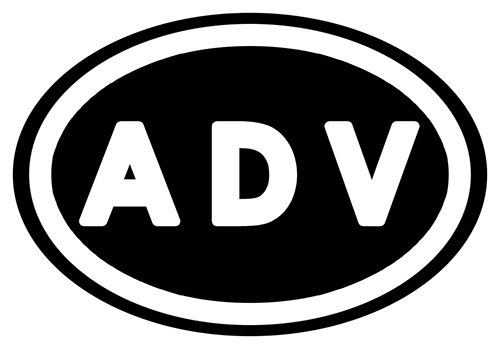ADVICE AND INFORMATION
Whilst we don't claim to have visited absolutely every inch of Australia, we've seen more than our fair share. We've ridden the highways, rattled along the tracks, powered through the deserts, ranged up the mountains, slipped through the valleys and roamed deep into the Outback.
The information provided here is intended to give you some knowledge to help you stay safe in country, a bit of background to main states and we've also aimed to explain some of the more potentially confusing aspects of hiring a bike in Australia.

MORE ADVICE AND INFORMATION
-
GENERAL ADVICE
-
BIKE SETUP
-
DOCUMENTS
-
INSURANCE
-
SECURITY BOND & EXCESS EXPLAINED
-
GPS, SAT-NAV AND DIGITAL MAPS
-
SELF-GUIDED TOUR NAVIGATION
-
LUGGAGE TRANSPORT
-
BREAKDOWNS & SERVICE PLEDGE
-
CANCELLATION POLICY EXPLAINED
-
OTHER FEES, TOLLS, FINES ETC.
-
BOOKING TERMS & CONDITIONS
STATE GUIDES
-
STATE GUIDE:
NEW SOUTH WALES
-
STATE GUIDE:
VICTORIA
-
STATE GUIDE:
QUEENSLAND
-
STATE GUIDE:
WESTERN AUSTRALIA
-
STATE GUIDE:
SOUTH AUSTRALIA
-
STATE GUIDE:
TASMANIA
-
STATE GUIDE:
NORTHERN TERRITORY
G’day!
The information you find here is written for you, to give a rough idea of what you might be reasonably confident on experiencing in Australia. Forewarned is forearmed so the saying goes! I’m writing this after experiencing some, if not all of the possible scenarios on my own round Australia motorbike trip. Hopefully you’ll find it interesting.
The information should be useful for short and long term rides, but is orientated towards a trip planned mostly around camping, motels and hostels. Some of the advice may make you wonder what on earth you are letting yourself in for, but in reality you’ll be safe if you take a few precautions and use some common sense!
A good book on touring Australia will help you get the most out of your trip. It will tell you about tourist destinations, what to expect when you get there, accommodation, places to eat and just about everything else. There are more titles than could possibly be mentioned here, covering all styles of travel. Pick the one that suits you best.


Mark – Circumnavigated Australia 2002-2003
GENERAL ADVICE FOR RIDING IN AUSTRALIA
The sun, the weather and the time of year to visit:
Australia has two basic climate zones and the southern and northern halves of the country must be treated very differently. In the northern half it is warm, bordering on hot all year round but in the summer (late November to April) it becomes the ‘wet‘ season. This is the time when the humidity ramps up into the unbearable end of the scale, it gets extremely hot, very wet and rather prone to cyclones (hurricanes).
This is not a great time of year to visit the ‘Top End‘ as roads are sometimes impassable (even surfaced ones) and it’s just uncomfortably hot and far too humid. The winter in the north and centre of Australia is peak season, as temperatures are typically high 20s and 30s, it is not humid and it’s generally referred to as the ‘dry‘ season. Bear in mind though, it can get very cold in the desert at night.
Southern Australia is much more Mediterranean and even temperate in the far south. Warm, dry summers and cool, wet winters are the normal state of affairs. Spring through to Autumn is a lovely time of year to travel here. Winters can be cold with temperatures typically between 5 and 18 degrees centigrade along the south coast during the day. The Victorian Alps and Snowy Mountains in the south east will be covered in snow during the winter and will be very cold and icy – no fun on a bike!
Whenever you go, sun tan lotion, a hat and sunglasses are essential.
Accommodation:
Australia is extremely well prepared for the traveller and is perfect for those looking for a taste of the great outdoors. Campsites can be found almost everywhere and are mostly clean and well kept. You’ll pay anything from AU$10-30 per day for a two man tent, depending on where you are. National parks and other remote areas often have bush campsites. These are off the beaten track and provide useful basic facilities such as pit toilets and an area for a fire (always check fire restrictions before starting one). These sites are great if you enjoy getting back to nature and you’ll find birds and animals all around. There’s nothing better than sitting round your fire cooking dinner, supping on a beer and gazing up at more stars then you ever knew existed.
On those rainy, cold days (they do happen in Australia sometimes!) when some comfort is welcome, then motels are a good choice and will usually cost about AU$75-130 per night. Backpacker hostels are also good value and make meeting other travellers easy. You can either sleep in a dorm with a number of others, which is the cheaper option, or take a room on your own and take the associated price increase on the chin. Call in advance if you are hoping to stay in a hostel somewhere popular, as they can be very busy. There are many books with details of accommodation and if you use your guide book for nothing else than finding somewhere to sleep, then it was worth bringing it along!


Insects, flies and other annoyances:
Flies can be incredibly aggravating at certain times of year in some area,s but it’s surprising how quickly you get used to a few of them hanging around! When things get really bad, it’s worth investing in a hat with a fly net or save the corks from your wine bottles and tie them on – it really does work. Not only that, it’s a pretty cutting fashion statement too! Insect repellant is a must. Even if you think there’s no chance of mosquitoes or sand flies, there are normally some around to prove your wrong, so make it a regular routine to put it on in the morning and if you stop for long periods.
Dangerous animals:
Before you leave for Australia everyone will be telling you that you’ll end up envenomated by a snake, bitten by a spider, chewed on by a crocodile, eaten by a shark or stung by deadly, deadly jellyfish. Whilst they’re all extremes, the possibility does exist in Australia that you’ll come across a creature with the potential to do you harm. The chances of this are very slim but a few sensible rules should be followed.


Snakes don’t want trouble so walk heavily as you go through the bush and they’ll be long gone before you see them. Always wear boots protecting your ankles and toes when walking in the bush and don’t rummage or sit on sticks, leaves or other piles of debris as that’s where like to hang out. Don’t leave your shoes and clothes outside your tent at night as roaming spiders might well take a liking to them, keep the mosquito net zipped up on the tent and always be mindful of where you choose to set up camp.
Pick up chairs and tables by their sides and not with your fingers underneath,as you may disturb a spider. ALWAYS adhere to signs warning of crocodiles and ‘stingers’ and don’t swim on tropical shores during the wet season when jellyfish are about. It’s always reassuring to be acquainted with the right course of action in the event of a bite or sting, so a little research before you arrive may give you some peace of mind. A bit of first aid knowledge is always handy wherever you are of course!
PREPARATION BEFORE YOU LEAVE
Firstly, always prepare a detailed list of things to take and then check it thoroughly before leaving home. Leaving your credit cards and cash at home won’t make for a good start to your bike trip!
Documentation:
Don’t forget to take your bike license, passport with visa, flight tickets, booking confirmations, credit cards and cash, travel books etc. We strongly recommend you obtain personal health and general travel insurance before you depart for Australia.
Luggage on a bike:
The more you bring the heavier the bike will be and the more difficult it can be to handle, so think carefully about your list of items and minimise them wherever possible. The bikes often include panniers but you’ll probably need a rucksack (not with a frame), or large zip up duffel style bag as well. It’s always handy if the pack is waterproof too, just in case you encounter rain along the way. A small rucksack for everyday items is useful so that you don’t have to keep unstrapping everything to get at often used things like your camera.
Remember you will need to carry water and probably extra petrol at times if you take some of the more remote Outback tracks. On top of that you’ll need room for your tent. Cargo net type bungees are good for keeping things in place, and you’ll need at least a couple of standard ones. It may be a luxury, but a cheap collapsible chair means you have somewhere to sit outside your tent when you’re eating. It’s much nicer than sitting on the ground and keeps you away from the ants! Packing items you want to stay completely dry in separate plastic bags inside the main pack, is always a sensible option too.


Clothing and footwear for riding:
Australia is often hot but it can also be very cold and wet and on a bike you’ll need to cater for these situations. Touring is no fun when you’re cold and wet, plus you’re much more likely to make mistakes. A good pair of biking gloves is essential, as is an armoured jacket. Leather trousers are useful if you are spending any length of time in the southern part of Australia, as the weather can be very variable especially if you climb in altitude. Warm under-clothes are a must in the alpine regions. Textile rather than leather riding gear is always an option too, but it depends on what you’ve got available of course and it will all serve the purpose.
Proper bike boots are ideal but when you’re trying to save space and weight, a good pair of walking boots will serve you on and off the bike. It goes without saying that an approved motorcycle helmet should be worn at all times.
Useful extras include a small torch, headlamp, notepad and pencil, self inflating bed roll and nylon chord or string.
RIDING HINTS AND TIPS
Resting:
At some stage of your trip you’ll probably spend a long time holding the throttle in one place. It hurts after an hour or two and you should plan to stop and stretch regularly. Some ingenious devices have been invented to act as a cruise control for bikes, making use of various items such as radiator hoses over the bar end and throttle grip. t’s obviously very dangerous if your throttle sticks open so beware, we certainly wouldn’t recommend it that’s for sure! It also helps to develop a simple routine of stretches and muscle contractions if you’re trying to cover a lot of ground each day.
Falling asleep:
You’ll see signs all over Australia warning you of the consequences of falling asleep whilst driving. It is one of the biggest killers on the roads here, so if you feel drowsy don’t take chances. There are plenty of rest stops along all routes in Australia, so there are no excuses. Some places even offer free “driver reviver’ coffee stops.
Air conditioning:
Ordinarily the exclusive domain of vehicles with roofs, it doesn’t mean you can’t have air conditioning on your bike too. “On a bike?” I hear you say, well let me explain. Temperatures in excess of 40 degrees centigrade are quite common at certain times of year in much of Australia, so you’ll get hot, bloody hot. Asphalt reflects this heat and it’s like riding in an oven.
An evaporative air conditioning system is easily available to you however. Take an old T-shirt, soak it in water at every opportunity and put it back on (don’t use your drinking water). Do your bike jacket up and as you go along the water evaporates making you feel cool! It never stays wet for long so control the amount of cooling via the zip. Genius!


Animals and travelling at night:
The rule for travelling at night, dawn and dusk is simple – don’t! Animals feed at this time and hitting a kangaroo, camel or wombat will hurt a lot (or worse) and almost certainly wreck your bike. Not a nice way to end a trip. The kangaroos often like to lie in the road to soak up the warmth as the sun goes down, so keep your eyes peeled for the sunbathing critters!
You should also watch out for large birds (often wedge tailed eagles) on road kill. They don’t like to leave their food and sometimes fly off at the last second in your direction. An eagle with a wing span of 9 feet will hurt a lot if you hit it! The same is true of emus. When panicked they can run along the side of the road, turn suddenly and run across your path. Whatever the animal, slow down and make sure it is out of harms way before you pass.
Roads, or possibly not:
For the most part Australian surfaced roads are in good shape and you can get to the majority of the tourist sites without leaving them. Many travellers want to see some of the less ridden routes and to do this, you’ll ride on roads without the ‘black top’. The condition of these can vary dramatically and it’s worth asking locals or the police what to expect. Many of them will require a dual purpose or enduro style ‘adventure’ type bike.
In the north the wet season can make many roads impassable and it’s best to avoid the area at this time of year. At other times the roads range from smooth, firm gravel to deeply corrugated and very soft. Beware of the bull dust that collects in large holes on some outback roads. It’s difficult to see and even more difficult to control your bike when you hit it. If you’ve little or no experience off road just take your time and ride to the conditions. Don’t try and be a hero. It’s just not worth the consequences of a nasty accident especially in a remote location.


Speeding:
With the exception of some parts of the Northern Territory where there are no speed limits the police are extremely rigorous when it comes to speeding. Mobile cameras are used in many cities and if you are just 2-3kph you’ll be in for a fine, so keep to the limits.
Drink driving:
There was a day when distances were measured in the amount you could drink between two places. One town to the next might be a six-pack or a long journey could be a crate (24)! Those days have thankfully long gone and drink driving is just as socially unacceptable as it is in many other parts of the world. If you do then one large, typically Australian billboard I’ve seen sums you up…”If you drink and drive you must be a bloody idiot!” No expensive marketing man needed for that succinct slogan! If you’re drinking, leave the bike at the camp site or motel.
Water crossings:
Water crossings can be dangerous so don’t go rushing in. Look carefully and walk your route first, unless you suspect the presence of crocodiles. Check for large boulders and holes. It’s generally best to take your luggage off the bike if necessary and carry it across first. Push the bike through if it’s safer, rather than riding it and risking falling off and sucking water into the engine.
In northern Australia in the wet season, water levels can rise very rapidly and the force of water can be stronger than you think. Storms are very heavy but often short. If you get stuck between two rivers the best thing to do may be to wait as levels go up very quickly but come down just as fast. You may be there for a day or two but that’s better than chancing your luck in the water. Finally, keep an eye out for crocs if you’re in the northern reaches and around water.


Petrol, oil and water:
Don’t take chances with these. In hot areas you’ll drink much more than you expect and if you reach the point where you are thirsty you’re not drinking enough. Plan for about 10 litres a day – more if you need it for cooking or if you intend to walk in the bush. Don’t rely on other travellers to have spare petrol, oil or water – they’ll need it for themselves! Plan your route carefully and check that you have plenty spare when you reach the next roadhouse or town. Be very careful if you intend to go into remote regions.
Planning your route and daily preparation:
Always take a detailed map especially if you’re in remote regions. In these areas talk to local authorities about your intended trip and always plan your route carefully, noting roadhouses and towns and work out the distances to cover. Be aware of possible wrong turns – it can literally save your life. Imagine travelling on a track when you unknowingly take a wrong turn. You reach the point where you don’t have sufficient fuel to return to civilisation before realising you’ve gone the wrong way. You may be stuck in a hostile environment for days before anyone comes along – if you’re lucky.
It’s no exaggeration to say that many have died making this kind of mistake. Remote trips are incredibly exhilarating but you must plan the distances and points of return properly. ALWAYS let others know (local police for example) your route and estimated time of arrival and be sure to check in as soon as you arrive. Buying or hiring an emergency radio or satellite beacon may be wise in very remote areas.
Tools and useful extras:
A toolkit is often included with the bike but there’s a couple of extras you might find handy. Firstly, always carry a good knife. You may only need it for opening beer bottles but it can also be put to many other uses. Another handy item is a tube of ‘liquid metal’ or similar, it cures to a solid and can be used to fill holes in sumps, repair petrol tanks etc. Interestingly, soap can be used to fill a hole in a petrol tank as fuel won’t dissolve it. Another outback quick fix is putting pepper into a holed radiator to stop the leak!
Breakdowns and punctures:
Australians are generally extremely friendly and will help if you’ve broken down and are really stuck. If on a long term hire bike then the toolkit and spares will cover spare levers, belts, inner tubes, clutch cables and the like helping to deal with many common problems.
Hopefully you’ve found this information useful and interesting. If you have any other questions about riding in Australia, the best places to go, times to visit and what bike to ride, just drop us a line. We’ll be happy to help!


